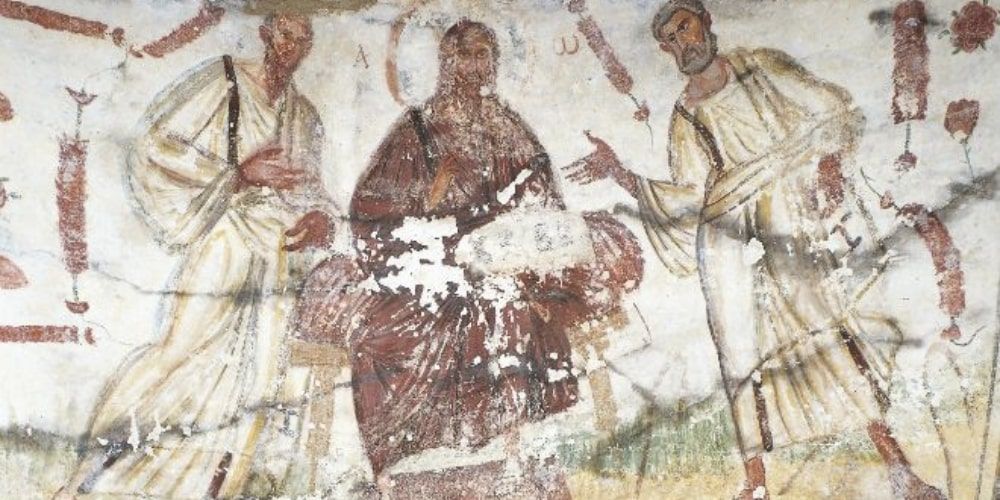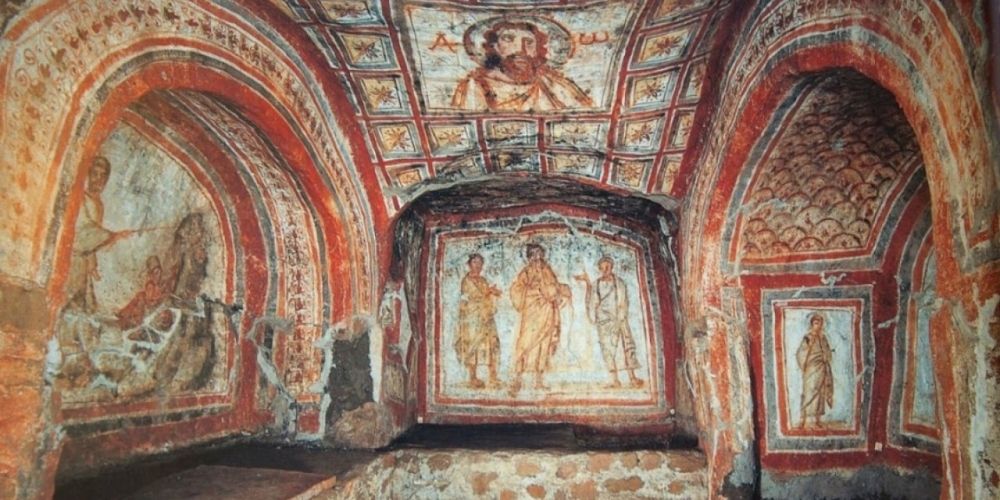In this article we take you on a discovery of some of the most impressive catacombs in Italy. Come with us on this itinerary among the underground treasures along the peninsula to enjoy an experience that we can undoubtedly call unique in the world.
The largest and most famous catacombs are in Rome and Naples, but in this list we also present two special cases, one in Sicily and the other in Basilicata.
Let's see in detail what they are and how to plan a visit.

What catacombs are?

In the collective imagination, catacombs are places full of mystery and fascination because of their underground location, which makes them unique in their kind.
Catacombs, in fact, are ancient Christian cemeteries dug underground in the late 2nd and early 3rd centuries AD and consists of long, narrow, low tunnels called ambulacra in whose walls tombs or loculi were dug.
Catacombs are almost always decorated with frescoes depicting episodes from the Old and New Testaments but also with subjects taken from pagan myths and everyday life. The walls are often marked with inscriptions, symbols and signs, and the tombs are engraved with the deceased's name, age and date of death.
Throughout Italy, from north to south, there are important catacombs: in Veneto at Concordia Sagittaria, in the province of Venice, where mostly deceased military personnel are buried; in Emilia Romagna near Ravenna the catacombs of San Severo, Sant'Apollinare, Probo and Eleucadio; in Tuscany in the Valdichiana Senese, near Chiusi, are the catacombs of Santa Mustiola and those of Santa Caterina d'Alessandria; in Umbria in Massa Martana the catacombs of Villa San Faustino; in Abruzzo San Vittorino in Amiterno and those of Castelvecchio Subequo; in Latium Santa Cristina in Bolsena, Soriano nel Cimino, Nepi, Albano, Grottaferrata; in Basilicata in Venosa; in Apulia in Canosa; in Calabria in Tropea; in Sicily in Syracuse, Trapani, Palermo; and in Sardinia in Sant'Antioco.
10. Catacombs of the Capuchins, Palermo
The Catacombs of the Capuchins in Palermo date back to the 16th century AD and are a unique site and among the most impressive in the world.
In fact, the catacombs house some 2,000 standing or lying mummies, richly dressed and divided by age, sex and social category.
Originally this was the burial place of the Friars of the Capuchin Order, who in 1597 decided to expand the existing cemetery and began excavating the Catacombs. When the Friars excavated to transfer the bodies to the Catacombs they noticed that some of the bodies had mummified naturally. From then on, the bodies were displayed in niches along the walls of the first corridor of the Catacombs. The first to be buried there was Friar Sylvester of Gubbio on October 16, 1599.
From 1783 burial was officially granted to all those who could bear the costs of embalming. It became, therefore, necessary to expand the catacombs with the construction of new corridors.
The cemetery was closed in 1880 but two bodies were still received: that of Giovanni Paterniti, vice-consul of the United States in 1911; and that of little Rosalia Lombardo, who died in 1920 at only two years old and is known today as the 'most beautiful mummy in the world’.
9. Jewish Catacombs of Venosa - Potenza, Basilicata
The Catacombs of Venosa were built to bury the dead of the Jewish community and are an important testimony to the cult of the dead in the Jewish colony of the ancient Roman city between the 4th and 6th centuries AD.
The structure is the same as the Christian ones: underground tunnels in whose walls are dug narrow and long loculi or other burials organized in cubicles and arcosoli often decorated in frescoes with symbols of the Jewish iconographic tradition such as the menorah (the seven-armed candelabra).
The funerary inscriptions found in the Jewish catacombs of Venosa and dated from the 4th to 9th centuries AC have been called 'the best cross-section of southern Jewish society between Late Antiquity and the early Middle Ages' and give us a detailed picture of the organization of the local Jewish community, its wealth and the high social status of its members.
8. Catacombs of St. Agnes, Rome
The Catacombs of St. Agnes are named after the young Agnes, who was martyred at the age of only 12 as a result of persecution against Christians, and her cult became one of the most widespread in ancient Rome.
The saint was buried in a pre-existing underground cemetery, and on the site of the original burial a small basilica was later built, now semi-buried, whose apse is decorated with a beautiful mosaic on a gold background depicting Agnes between Popes Honorius and Symmachus and other important evidence of the saint's cult.
Others were added to the original nucleus of the catacombs over time but the entire complex was later abandoned and was badly damaged by treasure and relic seekers.
The Mausoleum of St. Constance dedicated to the daughter of Emperor Constantine, one of the most important monuments of late antique architecture, was later built in this area.
Book now your visit7. Catacombs of St. Callistus, Rome
The Catacombs of St. Callistus are among the largest and most important in Rome.
They take their name from Pope Callistus who, upon ascending to the papal throne, enlarged the pre-existing funerary complex and thus the Catacombs of St. Callistus became the official cemetery of the Church of Rome.
The catacombs are composed of several areas: The Crypt of the Popes, where nine pontiffs are buried; the tomb of St. Cecilia; the Region of St. Milziades; the Region of Saints Gaius and Eusebius; the crypt of the martyrs Calochero and Parthenius and other cubicles.
All the catacombs are decorated with splendid paintings with Byzantine characters, and there are some of the oldest frescoes in the Roman catacombs.
Book your visit now6. Catacombs of Saints Marcellinus and Peter, Rome
The Catacombs of Saints Marcellinus and Peter were named after the martyrs buried there and arose on the site of an existing necropolis.
The archaeological area, known as 'ad duas lauros' (‘at the two laurels’), also includes the Mausoleum of Helena, which can no longer be visited, and the necropolis of the Equites Singulares, the emperor's mounted guard.
The catacombs are decorated with a rich pictorial heritage of frescoes depicting stories from the Old and New Testaments, and Saints Marcellinus and Peter are depicted in one of the most famous frescoes in Christian art, located on the ceiling of the Cubicle of the Eponymous Saints: Christ is depicted enthroned clothed in a purple robe and at his feet the martyrs Gorgonius, Peter, Marcellinus and Tiburtius.
Book now your visit5. Catacombs of Domitilla, Rome
The Catacombs of Domitilla owe their name to Flavia Domitilla, niece of Emperor Vespasian, who owned the area on which the first burials of the Christian community arose.
They are among the most extensive in Rome with as many as 17 km of tunnels and underground passages and are the only ones that still have a visitable underground basilica which is dedicated to the martyrs Nèreo and Achìlleo, victims of Diocletian's persecution in 304 AD.
Another very ancient nucleus is the Hypogeum of the Flavians, which began as a private pagan hypogeum and then housed Christian burials. In the catacombs of Domitilla there are then other important rooms with burials characterized by rich decoration.
Book now your visit4. Catacombs of St. Sebastian, Rome
The Catacombs of San Sebastiano are named after the martyr who was laid to rest here after his death in 298 AD.
Originally a pagan cemetery where mostly slaves were buried, it later became a Christian necropolis.
The site was originally called ad catacumbas (at the hollows), due to the presence in the area of pozzolan quarries, and it was the complex of St. Sebastian, which over the centuries became one of the most important in Rome, that gave the name 'catacomb' to all other Christian underground cemeteries.
Here it is possible to visit cubicles, the Crypt of St. Sebastian and three Mausoleums used for the burial of members of wealthy families all decorated with mosaics, frescoes and graffiti by devotees.
Book your visit now3. Catacombs of Priscilla, Rome
The Catacombs of Priscilla are named after the woman who donated the land on which the first burials of the Christian community arose and have been called 'The Queen of the Catacombs' because of the high number of martyrs buried there.
In the fifth century AD they were abandoned and during the barbarian invasions were despoiled of tombstones, sarcophagi and relics; fortunately, the hypogean rooms still retain their mosaic flooring and are frescoed with paintings of particular beauty and value: in the vault of a gallery in the Arenarium appears the oldest depiction of the Madonna and Child that has come down to us (late 2nd-early 3rd century), and in the 'Cubicle of the Veiled Woman' there is a very well-preserved fresco of a veiled woman in an attitude of prayer with her arms in the air, and then more Old and New Testament episodes, faux-marble decorations and stuccoes.
Book Now your visit2. Catacombs of San Gaudioso, Naples
The Catacombs of San Gaudioso are named after the Pope who was buried there around 450 AD. The burial site became an object of worship, and the pre-existing early Christian underground cemetery was expanded to create the catacombs, the second largest in Naples.
The catacomb of San Gaudioso preserves valuable frescoes and mosaics from the 5th and 6th centuries, and the fresco of the Madonna della Sanità, the oldest depiction of Mary in Campania, also dates from this period.
After a long period of neglect, in the 17th century the catacombs were again used for the burials of aristocrats and ecclesiastics who were buried according to the rite of 'draining', that is, the corpses were put to drain to let out all the fluids after which the bones were washed and placed in their final burial. The burials were made according to a special procedure: the skulls were set into the walls of the ambulatory, while the rest of the body was frescoed, usually with clothing and attributes representing the social position of the deceased.
Book your visit now1. Catacombs of San Gennaro, Naples
The Catacombs of San Gennaro are the most important monument of Christianity in Naples and date back to the 2nd-3rd centuries AD.
The original core consisted of the tomb of an ancient family into which, after later modifications, the remains of St. Gennaro were moved in the 5th century AD.
From that time the catacomb became a center of worship of the martyr and was named after him.
The great devotion of the Neapolitan people to St. Gennaro led to an extraordinary development of the catacombs with the construction of new ambulatories and the opening of new tombs. They also preserve a rich pictorial heritage, with pagan depictions and Byzantine paintings, and hold the first Christian paintings in southern Italy.
During the 18th century the Catacombs of San Gennaro became an obligatory stop on the Grand Tour and an ad hoc guide was even compiled for the visit, and during World War II they were used as an air raid shelter for the population.
In 2006 the site was opened to the public, and in 2021 the Catacombs of San Gennaro won the title of best experience in the world.
Book your visit nowAbout the author
Written on 24/03/2023










Mariateresa Bonanotte
What are the most charming catacombs in Italy? We have chosen 10, let's find out together which ones they are.